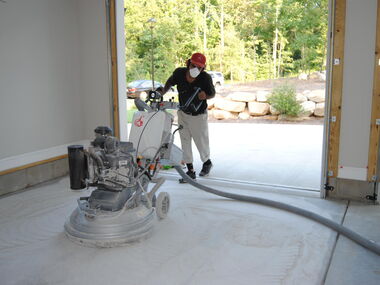Interior vs. Exterior Paint: Can You Use Exterior Paint Inside?

You’ve got plenty to think about before painting the inside of a room. Which kind of paint should you buy? How much will you need? What will it cost? The list of questions and considerations only continues from there. As you mull over these matters, you might come across exterior paint colors that would work just as well indoors. Then you might wonder why there’s a categorical divide between exterior paint and interior paint, to begin with. While marketing has plenty to do with these distinctions, there are actual differences between paint used for outdoor surfaces and interiors. The question remains, however, can you use exterior paint inside? For better or worse, the complete answer to this question requires some nuance, which we’ll discuss here.
What to Know About Using Exterior Paint Inside
What Makes Interior and Exterior Paint Different?
To understand whether or not exterior house paint can be used for interior projects, you must first grasp what makes these two types of paint unique. Consider that interior and exterior surfaces deal with different environments – an interior wall is at risk of getting scuffed, scratched, dented, and covered in dust, whereas exterior siding has to deal with UV rays, moisture, wind, pests, and other climate conditions. The paint formulas manufactured by major brands are designed with these different conditions in mind. In other words, interior paints are primarily designed to resist staining and abrasion, while exterior paints deliver additional durability to withstand the weather.
As a result, interior and exterior paints feature different compositions. Exterior paint might look identical to interior paint of the same color, but it often contains a higher level of volatile organic compounds (VOCs) to boost its durability. Indeed, most interior paints contain few, if any, VOCs. The presence of these VOCs is one of the main reasons experts recommend using exterior paint only for exterior projects.
What Happens If You Accidentally Use Exterior Paint Inside?
As mentioned above, exterior paint products often contain significant levels of VOCs. As the paint dries and cures, it releases these harmful VOCs into the air. If exterior paint is used inside a poorly ventilated room, the harmful gasses will accumulate and pose health risks to occupants. These VOCs, as their name indicates, pose a short- and long-term health risk to individuals in close, consistent proximity, including but not limited to:
Irritation of the eyes, nose, and throat
Liver, kidney, and central nervous system damage
Headaches
Loss of coordination
Nausea
Potential for cancer in animals
While many paint manufacturers are doing their best to reduce the number of such chemicals in their products, VOCs are still commonly found in exterior paints. Fortunately, using these products outdoors minimizes the adverse health risks outlined above. When used inside, however, VOC emissions can linger for a long time and increase the odds of such negative consequences. As such, exterior paint isn’t often used nor recommended for interior painting. If nothing else, exterior paint tends to cost more than interior alternatives, so sticking with interior paint for indoor projects also keeps costs lower.
What to Do If I Used Exterior Paint Inside?
If you accidentally painted your interior with exterior paint, remove the paint and repaint the area as soon as possible. Aside from the health risks of constant exposure to exterior paint, your indoor space will smell like paint for quite a while if you don’t immediately remove it. Repainting will cost you more, but it will be more beneficial for your health in the long run.
However, there are exceptions to this rule. You can identify indoor areas where it’s completely okay to use exterior paint.
Exploring the Exterior Paint Exceptions
Just because exterior paint is primarily advised for exterior painting projects doesn’t mean it cannot be used for interior painting as well. There are some exceptions worth noting. For instance, areas that share indoor and outdoor elements and/or are rarely occupied for long periods of time (such as sheds, pool storage rooms, detached garages, etc.) can benefit from the added durability of exterior paint without putting people or pets at risk of prolonged VOC exposure. Likewise, some exterior paints are great for combatting indoor moisture and mold growth in areas such as bathrooms, basements, and kitchens – it’s best to go this route if you plan on leaving the space unoccupied and well-ventilated for several weeks after painting, however, as this will mitigate VOC emissions.
Considerations When Using Exterior Paint Inside Your Property
Chances are, you wouldn’t intentionally buy exterior paint for interior painting projects. You probably wonder if you can use exterior paint inside because you already have it on hand and don’t want it to go to waste. Although you can use exterior paint in some areas of your home or commercial space, you must consider a few factors before you start painting. For example, what’s the sheen (finish) of the paint? Note that high gloss paint will magnify any surface imperfections. Is the paint oil-based or water-based? Oil-based paint generally emits higher VOCs and a strong odor. Water-based paints contain less VOCs and don’t have a strong smell.
Safety Precautions for Using Exterior Paint Indoors
If you use exterior paint indoors, take safety precautions. Wear a respiratory mask that can block paint vapors and organic chemicals. Open the windows and use fans to boost air circulation indoors. Still, ensure you close air vents, doors, and other openings that will allow VOCs to spread to the rest of the house. Take breaks every half an hour to get fresh air and to avoid long exposure to VOCs.
The Short Answer
So, can you use exterior paint inside? In short, yes. Should you? In most cases, no. If, however, you understand the potential pros and cons of using exterior paint for interior projects and plan accordingly, you can reap the rewards of the additional resistance outdoor paints have to offer your interior spaces. The experts at Anderson Painting are well-versed in all paint types and their various uses. If you need help navigating these waters for your upcoming Raleigh, NC, painting project, we’d be happy to help.
To learn more about us and all we do, call today at 919-610-1855 or email us at info@andersonpaintingnc.com!




